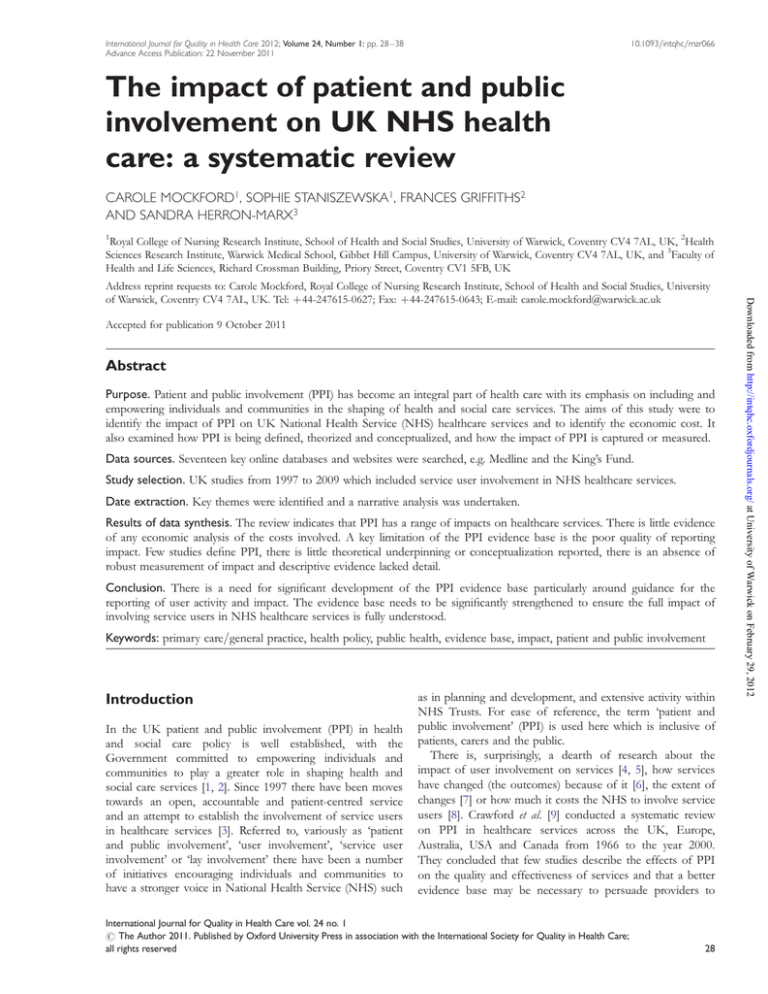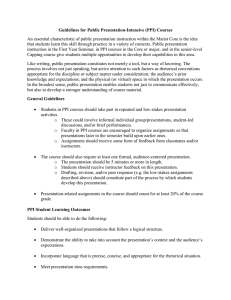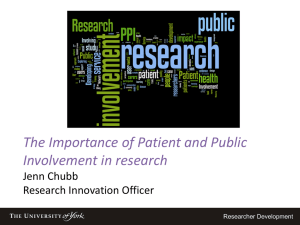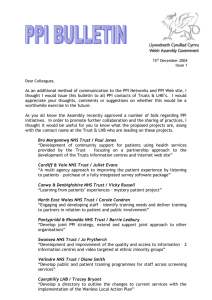The impact of patient and public involvement on UK NHS health
advertisement

International Journal for Quality in Health Care 2012; Volume 24, Number 1: pp. 28 –38 Advance Access Publication: 22 November 2011 10.1093/intqhc/mzr066 The impact of patient and public involvement on UK NHS health care: a systematic review CAROLE MOCKFORD1, SOPHIE STANISZEWSKA1, FRANCES GRIFFITHS2 AND SANDRA HERRON-MARX3 1 Royal College of Nursing Research Institute, School of Health and Social Studies, University of Warwick, Coventry CV4 7AL, UK, 2Health Sciences Research Institute, Warwick Medical School, Gibbet Hill Campus, University of Warwick, Coventry CV4 7AL, UK, and 3Faculty of Health and Life Sciences, Richard Crossman Building, Priory Street, Coventry CV1 5FB, UK Accepted for publication 9 October 2011 Abstract Purpose. Patient and public involvement (PPI) has become an integral part of health care with its emphasis on including and empowering individuals and communities in the shaping of health and social care services. The aims of this study were to identify the impact of PPI on UK National Health Service (NHS) healthcare services and to identify the economic cost. It also examined how PPI is being defined, theorized and conceptualized, and how the impact of PPI is captured or measured. Data sources. Seventeen key online databases and websites were searched, e.g. Medline and the King’s Fund. Study selection. UK studies from 1997 to 2009 which included service user involvement in NHS healthcare services. Date extraction. Key themes were identified and a narrative analysis was undertaken. Results of data synthesis. The review indicates that PPI has a range of impacts on healthcare services. There is little evidence of any economic analysis of the costs involved. A key limitation of the PPI evidence base is the poor quality of reporting impact. Few studies define PPI, there is little theoretical underpinning or conceptualization reported, there is an absence of robust measurement of impact and descriptive evidence lacked detail. Conclusion. There is a need for significant development of the PPI evidence base particularly around guidance for the reporting of user activity and impact. The evidence base needs to be significantly strengthened to ensure the full impact of involving service users in NHS healthcare services is fully understood. Keywords: primary care/general practice, health policy, public health, evidence base, impact, patient and public involvement Introduction In the UK patient and public involvement (PPI) in health and social care policy is well established, with the Government committed to empowering individuals and communities to play a greater role in shaping health and social care services [1, 2]. Since 1997 there have been moves towards an open, accountable and patient-centred service and an attempt to establish the involvement of service users in healthcare services [3]. Referred to, variously as ‘patient and public involvement’, ‘user involvement’, ‘service user involvement’ or ‘lay involvement’ there have been a number of initiatives encouraging individuals and communities to have a stronger voice in National Health Service (NHS) such as in planning and development, and extensive activity within NHS Trusts. For ease of reference, the term ‘patient and public involvement’ (PPI) is used here which is inclusive of patients, carers and the public. There is, surprisingly, a dearth of research about the impact of user involvement on services [4, 5], how services have changed (the outcomes) because of it [6], the extent of changes [7] or how much it costs the NHS to involve service users [8]. Crawford et al. [9] conducted a systematic review on PPI in healthcare services across the UK, Europe, Australia, USA and Canada from 1966 to the year 2000. They concluded that few studies describe the effects of PPI on the quality and effectiveness of services and that a better evidence base may be necessary to persuade providers to International Journal for Quality in Health Care vol. 24 no. 1 # The Author 2011. Published by Oxford University Press in association with the International Society for Quality in Health Care; all rights reserved 28 Downloaded from http://intqhc.oxfordjournals.org/ at University of Warwick on February 29, 2012 Address reprint requests to: Carole Mockford, Royal College of Nursing Research Institute, School of Health and Social Studies, University of Warwick, Coventry CV4 7AL, UK. Tel: þ44-247615-0627; Fax: þ44-247615-0643; E-mail: carole.mockford@warwick.ac.uk Impact of PPI on NHS health care: a review † give a greater voice to patients when making decisions about services. However, to develop a robust evidence base and to enable comparisons and evaluations to be made, there also needs to be a common understanding of what is meant by ‘PPI’ in practice and how it can be conceptualized and measured. This paper, focusing on the UK, responds to the need for a better evidence base for PPI impact on services and economic cost by describing the findings from a systematic review of literature from 1997 to 2009. While UK focused, the implications of the study are likely to have relevance to a wider international PPI evidence base. Aims Methods An advisory group of 12 members, including two lay members and experts in the fields of PPI and systematic reviews, contributed to the study design. The group was also consulted at each stage of the study through regular meetings and by email. and internet websites comprised King’s Fund, National Library for Health, Invonet, Joseph Rowntree Foundation, Picker Institute, Social Care Institute for Excellence, theses websites and Opensigle (a closed library). Electronic databases and internet websites were searched for the period from January 1997 to February 2009 and the search was limited to UK studies written in the English language. As there was no Medical Subject Heading (MeSH) for ‘PPI’ a combination of search terms was used for the electronic databases (see Table 1) and a free text search related to ‘user involvement’, ‘consumer participation’, ‘PPI’ and ‘patient and public involvement’ was made on the sites where the search string was inappropriate. The search strategy was devised to maximize sensitivity and specificity. Reports and other non-peer reviewed documents were accessed via websites (above) and through citations. Study selection A total of 6110 titles and abstracts of studies were screened by one reviewer (C.M.) (after removal of duplicates) to include publications potentially relevant to the study. Where the abstract was unclear, brief or omitted, the full text of the study was obtained. Early in this screening process, a total of 248 of the 6110 titles and abstracts were screened by two other reviewers (F.G. and S.S.) to check inclusion/exclusion decisions. Where there was disagreement this was resolved by discussion and where necessary the inclusion/exclusion criteria were refined. Quality assessment Inclusion criteria The eligibility criteria were broad to capture all types of user/patient activity which involved patients, carers and the public working: (a) in a collaborative way with health professionals or management, e.g. as lay members of NHS committees or in condition-specific groups or (b) in a user-led way where the service user was leading the involvement activity. It was anticipated that many authors would report their findings as case studies [9]. All study types, from both peer reviewed and non-peer reviewed literature were included but discussion papers, think pieces or editorials were excluded. To develop a manageable focus for this study, studies of or from the following were excluded: children’s services, health research, NHS research and development, the voluntary sector, independent healthcare services and educational services. Studies of involvement as part of an individual’s health care were excluded. Information sources Electronic databases searched comprised Medline, Embase, Cinahl, Health Management Information Consortium, PsycInfo, British Nursing Index, Social Science Citation Index, Conference Papers Index and the Cochrane Library A quality appraisal tool for assessing the quality of studies from the Critical Appraisal Skills Programme [10] for Table 1 Search terms Set 1 Set 2 Set 3 Set 4 .................................................................................... Patient* User* Carer* Caregiver* Public Citizen* Client* Consumer* Lay Stakeholder* Representative* Relative* Famil* Survivor Health* NHS ‘NHS’ Involv* Participa* Collaboration Engag* Evaluat* Consult* Audit* Empower* Experience* Reform* Develop* Economic* Cost* Chang* Reconfig* Redesign* Impact* Outcome* Effect* Decision-making Policy-making Health planning Health priorities 29 Downloaded from http://intqhc.oxfordjournals.org/ at University of Warwick on February 29, 2012 The aims of this systematic review were: (i) to identify the impact of PPI on UK NHS healthcare services, (ii) to examine the economic cost of PPI. To achieve these aims, and to aid synthesis, the review also examined how user involvement is defined, theorized and conceptualized, and how the impact of user involvement is captured or measured. Patient experience, policy Mockford et al. research was used for assessing the quality of included studies. Table 2 Illustration of the results of the literature search Data extraction Analysis and synthesis of results Analysis involved familiarization with the studies, comparison of studies and then interrogation of the extracted data for each of the research questions. A narrative synthesis was developed examining relevant themes and identifying patterns and anomalies across the studies. Results Study selection The search strategy identified 6110 abstracts. However, only 64 of these initially met the inclusion criteria for the review. During full text data extraction, a further 22 papers were excluded as on closer inspection they did not meet the study’s inclusion criteria. Forty-two papers remained representing 28 studies (Table 2) of which 20 were case reports. The lack of specificity in the search strategy is possibly due to the term ‘PPI’ (an accepted acronym for the term ‘PPI’) being a common acronym used in unrelated studies, absence of information in the abstract and no MeSH term for ‘PPI’. Study characteristics The 28 studies comprised of 20 case studies or reports (many of which did not claim to be research), 5 evaluations, 1 survey and 2 secondary data analyses. The types of involvement studied were diverse including lay and professional members of Primary Care Groups or Trusts, audit teams and the inclusion of current and former patients in various activities such as leaflet design (see Table 3). 30 Quality assessment Most of the literature lacked sufficient detail about the study design or activity or why it was chosen to be able to apply the Critical Appraisal Skills Programme quality assessment [10]. Many studies gave very little description of the lay participants particularly lay members of Primary Care Groups or Trusts, omitting details such as age, gender, ethnicity, whether they were employed or not and any previous experience with working in health care. Most studies failed to describe how participants were recruited. There was little evidence to support the claims of the impact of PPI. Review results This review indicates that PPI takes many forms within UK NHS health care. This ranges from lay membership of NHS managerial boards such as the former Primary Care Groups, Primary Care Trusts and commissioning boards to patient involvement in condition-specific groups of individuals with a solitary aim (e.g. information distribution as in leaflet design or awareness campaigns). The impacts of PPI on NHS healthcare services were broadly divided into service planning and development, information development and dissemination and changing attitudes of service users and providers. These impact areas are described in the first section. The second section Downloaded from http://intqhc.oxfordjournals.org/ at University of Warwick on February 29, 2012 The data extraction form was developed and discussed and agreed by three reviewers (C.M., S.S. and F.G.). Data extraction was piloted to ensure sufficient detail would be extracted from the papers (C.M. and A.L.). Three researchers extracted data (C.M., A.L. and D.M.B.). Any disagreements were resolved by discussion. Extracted data were put into a database for comparison of the data. Extracted data included any definition concerning user involvement and details about the conceptualization and theoretical underpinning of patient and public involvement. The following was extracted for each study: study design, target population, health setting, period of the study, recruitment procedures and characteristics of the participants, data collection methods, type of measurement use, details of analysis and results specifically those concerning ‘impact’ and ‘outcomes’ directly or indirectly attributable to PPI, economic analysis or any references to cost. Table 3 Review characteristics Study Evidence Lay involvement Size of study Service Location Alborz [34] Structured interviews Lay member and postal questionnaires Survey of 72 PCGs PCG Nationwide Anderson and Florin [11] Interviews, observation and documentary evidence from meetings Interviews, observation and documentary evidence from meetings Lay member One PCG PCG Lay member One PCG PCG PCG Actual impact reported ............................................................................................................................................................................................................................................ Anderson and Florin [31] Lay member One PCG Berry [18] Lay member Summary of activities Primary Care PPI over a period of time forums Carney et al. [28] Interviews, observation and documentary evidence from meetings User group Former patients 22 patients Challans [17] Descriptive study Former patients as members of a clinical audit patient panel (CAPP) 20 patients Challans [32] Impact evaluation Former patients as members of (CAPP) 20 patients Cotterell et al. [12] Colorectal cancer services Primary care trust (PCT) PCT An awareness of patient and community interests; some moderation of professional values and priorities by alternative perspectives; improved links with the local community/voluntary sector Harrow East and Better knowledge of local health Kingsbury services among some local people. Impact has been limited to public information and education. A professional acceptance of the value of non-professional views in decision-making Kingston Some impact on culture of cleanliness Hospital and and hygiene, storage of equipment in Kingston wards, booking system, cultural needs of patients, and waiting times. Frenchay hospital Development of an information booklet for colorectal cancer Sheffield Improved information for patients, better access to other services. Introduction of drop in clinics and provision of training and education for GP staff Sheffield South Working partnerships with staff West improved Nationwide 31 (continued ) Patient experience, policy Interviews, observation and documentary evidence from meetings Dagenham Impact of PPI on NHS health care: a review † Anderson and Florin [26] Unclear or negligible impact. The 2000 Tracker survey reported that 21% of public involvement committees or working groups had a designated budget most of which were £5000 or less City and Hackney The creation of a local sickle cell centre. Increased understanding across the health economy Downloaded from http://intqhc.oxfordjournals.org/ at University of Warwick on February 29, 2012 Study Evidence Lay involvement Size of study Service Semi-structured questionnaires and telephone interviews Members of 34 cancer Summary of activities NHS Cancer networks which were part over a period of time Services of the Cancer Partnership Project Crawford et al. [8] Cross sectional survey User groups 74 user groups Crowley et al. [22] Mixed methods Lay member Stakeholders included PCG health professionals (60) and community activists (22) Dearden-Phillips and Fountain [24] Descriptive report Self advocacy user group Overview Learning difficulties Fudge et al. [25] Ethnographic case study Patient/carer User involvement stream Stroke services Milewa et al. [14] Semi-structured interviews Lay member 167 including 78 lay members PCG Moore [21] Cross sectional descriptive survey Patient 40 heads of audit Clinical audit Location Actual impact reported ............................................................................................................................................................................................................................................ Mental Health Trust Examples: development of standards for breaking bad news, information booklets and leaflets for patients, running an awareness campaign on the symptoms of testicular cancer, involvement in redesign of a cancer centre and the promotion of taped consultations Greater London Examples: improvements in ward environments, organization of out-patient services and systems for supporting patients in crisis. Service users had influenced service development and policies (but no details given) Newcastle West Minicoms were installed in acute trusts buildings. Staff reported that the project had changed the way they operated as they were now aware of user perspectives and health issues relevant to community, especially minority groups Cambridgeshire GP receptionists were trained in learning disability issues. Culture change with a new atmosphere of accountability, involvement and communication between service providers and users 2 London Peer support services and awareness boroughs campaigns. Information materials for patients with stroke. Good practice guidance for HCPs prepared Nationwide not Provision of additional services, including London changes in the configuration of services, changes to the Health Improvement Plans South East Coast Commode supplier changed as a and London result of patients’ feedback about the shape and discomfort Mockford et al. 32 Table 3 Continued Downloaded from http://intqhc.oxfordjournals.org/ at University of Warwick on February 29, 2012 Link person (between patient and PCG) and a lay member Survey of 69 Primary PCG Health Care Teams in Croydon plus in-depth interviews with a selection of PCG members Summary of activities Community health over a period of time Murie and Douglas-Scott [15] Mixed methods including postal survey and focus groups A range of initiatives including a patient participation group Peck et al. [20] Semi structured Lay member interviews, focus groups, observations of meetings 96 service users Somerset Mental health services and a Joint Commissioning Board Perkins and Goddard [13] Description None given Mental Health Trust South West London Pickles et al. [23] Case study using a story telling approach—evidence based design User panels and a trust-wide user and carer quality group. One user rep sat on trust’s governance committee, education and development group, etc. Patient/carer Not given Hospital Luton and Dunstable Cancer patients/people with family history of Report which included data from 7 patients Cancer genetic services Oldham Central Croydon Improved flow of information back to the patients in the way of leaflets, notice boards, educational meetings and self-help groups, information given in other languages Clydesdale, Scotland Some preliminary evidence of joint working between practice staff and the public including support for an integral pharmacy in the new medical centre; a local X-ray unit, enhanced services for carers, improvements to a waiting room area, an interactive mental health website, smoking cessation clinics, phase 4 cardiac rehabilitation, a multidisciplinary network for mental health services, a drop-in facility for teenagers, and an integrated evening care service A review of day care services was conducted by the Trust, the review was undertaken by a working group including service users amongst others (no further details given) Involved in the planning of buildings and environment. Community groups were involved in the provision of bigger lockers and colour of ward walls Richardson et al. (see also Cotterell et al. [16] Ripley et al. [30] Experiential report 40 plus improvements to the head and neck service at Luton and Dunstable hospital were achieved through user involvement Examples given are representation on committees, developing patient information, involvement in staff training (e.g. for breaking bad news), improving access to services User involvement mostly in awareness raising/publicity/lay information work 33 (continued ) Patient experience, policy In-depth interviews Impact of PPI on NHS health care: a review † Mountford and Anderson [19] Downloaded from http://intqhc.oxfordjournals.org/ at University of Warwick on February 29, 2012 Found strong support for PPI in PCTs. Support was less obvious at general practice level with little awareness or not seen as a priority but some saw a moderate level of support. Leaflet and guideline development Parents and members of an expert group 45 parents and 35 health professionals UK bloodspot programme London The impact of PPI on NHS healthcare services General Practitioner’s (GP). South [33] Stewart, and Oliver Report [29] Bradford 16 managers or PCTs Professional Executive Committee members Lay member Some evidence of improvements in patient oriented materials and some service improvement, e.g. patient held records, patient feedback systems Northern, Yorkshire and Trent collaborative Mental health 6 selected case studies Robert et al. [27] Case studies including semi-structured interviews, observations of meetings Audit including semi-structured interviews breast/bowel/ gynaecological cancers Service users Actual impact reported Location Service Size of study Lay involvement Evidence Study Table 3 Continued 34 considers the definition, conceptualization and measurement of PPI. The third section reports the Economic costs incurred from patient and public Involvement. Impact on service planning and development. Fifteen of the studies reported on the development of new and improved services attributed to user involvement. However, there was usually little description about how much influence service users had. Areas of impact could be grouped into seven categories as follows (with examples): † The design of new healthcare buildings and their environment [11 –13]. A mental health trust formed a series of ‘user panels’ and a trust-wide ‘user and carer quality group to advise on a new building and surrounding environment’ [13]. Another study described user involvement in the re-design of a cancer centre [12]. † The location of, and access to services [14 –17] such as the relocation of existing services [14] and the provision of transport and car parking [16]. † The provision of additional services. A survey indicated that 14 (28%) of 167 primary care groups could give examples of changes in provision of services. These included a service to give advice to teenagers on sexual health and contraception, extra physiotherapy sessions at the local hospital and extra provision for sufferers of back pain [14]. One study reported the setting up of an integrated evening care service [15]. † Re-organization of existing services [8, 18 –21] such as an improved booking service [18], changes to an appointment system [19] and a review of day services [20]. † Changes in organization of acute trusts [15, 18, 22, 23]. Minicoms were installed in an acute trust’s buildings at all key access points [22]. Improvements were reported in ward cleanliness and hygiene [18]. † Improved dialogue between health professionals and patients [12, 15, 17]. The ability to talk to professionals on an interactive health promotion website co-designed by service users [15]. User involvement in the development of standards for the breaking of bad news by professionals to patients [12]. A Parliamentary style forum between patients with learning disabilities and NHS management [24]. † Improved dialogue between patients and other patients [15, 25]. A peer support group for stroke patients [25], and a local support group and enhanced services for carers [15]. Impact on information development and dissemination. An important area of service user activity was around information development and dissemination. User involvement was described in producing public and patient information, raising awareness of chronic conditions and the development of training sessions for both service users and health professionals: Downloaded from http://intqhc.oxfordjournals.org/ at University of Warwick on February 29, 2012 ............................................................................................................................................................................................................................................ Mockford et al. Impact of PPI on NHS health care: a review † Patient experience, policy studies used a theoretical argument for their project. One study argued for collective self-advocacy in balancing the power between those with learning difficulties and those who have power over them such as parents or staff [24]. Another drew on social constructionism and post-modernism to challenge the professional narrative in mental health services [20]. Most studies relied on, and were driven by, current policy initiatives as their primary framework. Impact on attitudes of service users and providers. Many studies noted that working with service users contributed to changing health professionals’ attitudes, values and beliefs about the value of user involvement, although in many studies this was described as a difficult task [11, 21, 26, 31 – 33]. Several examples were given of the difficulties encountered in involving service users in service planning [19, 20, 33] such as service users had their own agenda for being involved, and that health professionals lacked time, resources and had little experience in working with service users. However, one study [31] reported success—there had been some moderation of professional values and priorities in one Primary Care Group, although many of the GPs involved had initially been unwilling to accept lay skills and values. In another study [32], staff were described as beginning to feel comfortable with working with lay members. Full costings of the economic outlay of PPI were not evident in the review literature but are an important part of assessing impact. No studies reported the full costs attributed to PPI, although some gave an indication of the cost of a variety of activities [12, 24, 33, 34]. One study found that 21% of public involvement committees or working groups had a designated budget of £5000 or less [34]. A study of stroke services [25] claimed there were funds available to employ a user involvement lead working 50% of her or his time on user involvement activities, administrative support, transport costs for service users to attend meetings, venue hire and expenses for service users. One study simply claimed that not enough funding was available [13]. No meaningful economic analyses were performed. The details that were available were too idiosyncratic for comparison or synthesis of cost across studies (Table 4). Definition of PPI Discussion It is important to understand the concept that studies are exploring and measuring and that there is some conceptual equivalence across the studies. Studies rarely provided an explicit definition of ‘user involvement’ or ‘PPI’ or any other similar term used. There were broad indications of what is understood by ‘PPI’. It is multifaceted and includes engagement [33] and communication [34] with the local community [33] focused on outcomes and improving local primary care services [31], based on building strong relationships between users and those in decision-making roles [24], direct, sustainable involvement at all levels [20, 24, 27, 30], openness [11] and acceptance and support [24]. Conceptualization of PPI. Conceptual or theoretical underpinning of the review studies was scarce; just two This review found many and varied PPI activities in the UK NHS healthcare services but the studies did not provide robust evidence of its impact and almost no evidence of its cost. There was a lack of consistency of definition of public and patient involvement and no reliable measurement tool. There are limitations to this study, for instance there has been no reliability testing of the papers included in this review due to a lack of sufficient detail; it focuses solely on PPI in the NHS in the UK and results of PPI in health care may vary in other international settings; the literature search was limited to the sources listed (see methods section), and there may be other literature which has not been identified, because of this some important insights may have been omitted. Measurement of PPI. Measurement could provide an effective way of understanding the extent of impact. However, there were no validated measurements mentioned specifically for capturing the impact of PPI. Data collection was undertaken using questionnaire surveys, semi-structured and structured interviews, focus groups, documentary analysis and observation of meetings. This captured mostly description of the activity and opinion about the difference user involvement has made. The variation in detail of reporting results prevented cross-study synthesis of impact. Impact was not captured through robust measurement using valid and reliable instruments. Economic costs incurred from PPI 35 Downloaded from http://intqhc.oxfordjournals.org/ at University of Warwick on February 29, 2012 † Production of public and patient information Ten studies described the production of public information either for the local community such as newsletters [26] or for specific groups of patients, such as revised patient information booklets [25] or leaflets [19, 26]. Specific health areas included mental health [27], cancer [12, 16], colorectal cancer [28], UK bloodspot programme [29], stroke [25] and head and neck services [23]. One study described service users compiling an information directory enabling patients to access existing resources more easily [16]. † Raising awareness Four studies described awareness raising through community campaigns on specific conditions such as diabetes [26], cancer genetics [30], testicular cancer [12] and stroke [25]. However, the level of involvement and influence of service users was unclear in these studies. † Developing/contributing to developing training sessions These were designed by, and for, other service users as part of a stroke initiative [25]. They were also held for health professionals to improve their understanding the patients’ perspectives for the training of General Practitioner’s (GP) receptionists [24] and in the breaking of bad news [16]. Mockford et al. Table 4 Reported economic costs of user involvement Study Nature of study Funding activity Source of funding Amount of funding ............................................................................................................................................................................. Alborz [34] Anderson and Florin [11] Cotterell et al. [12] Fudge et al. [25] Perkins and Goddard [13] South [33] Public involvement committees or working groups Report on PCGs and Targeted at activities rather their work for PPI than the core work of the organization The Cancer A partnership group of 34 Partnership Project networks with a committee of NHS patients, managers and health professionals to provide a more coordinated and integrated approach to user involvement A project adopting a One professional leader and Parliament style two full time service users approach to addressing issues in the learning disability sector A study of stroke A user involvement lead services working 50% of their time on activities; administrative support; transport costs for service users to attend meetings; venue hire; and expenses for service users A study of strategic, The trust employed a service operational and user to act as a consultant and individual attempts to link with local independent increase user user groups and other involvement in a constituencies of service mental health trust users, and to sit on other committees to represent local user groups A study of PPI in 4 Resources for supporting primary care trusts PCT-led activities and community-based and community-initiated projects Although many studies described the inclusion of service users in their activities and changes which were made as a result of their input, it was difficult to discern the extent of the involvement of service users. However, in a broad sense, user involvement is becoming a priority in the planning of services. Service users were also involved in the design and distribution of patient and public information, training programmes and awareness campaigns. It seems that utilizing individuals’ knowledge and experiences of conditions for the benefit of others is a particular strength of user involvement. Health professionals and managerial bodies seem to be beginning to value service user involvement. From a research and evaluation perspective, the findings from the review raise a number of issues. The definition of 36 PCG/Ts 21% had a designated budget of £5000 or less PCGs Funds were reported to be very limited MacMillan Cancer £150 00 per year relief and the Department of Health A partnership between a voluntary organization and local statutory body Charitable funding £60 000 a year Mental health trust Some funding was available for the local independent user groups. No details were given on the employed service user Core PCT money Budget allocations ranged from £42 000 to £150 000 There were enough funds available but they were ‘considerable’ PPI was not explicit in the studies. There was a lack of description of many aspects of the studies particularly in the study or activity design, and in the process of the data collection. The reports were often written in response to current policy initiatives with authors failing to provide a comprehensible theoretical or conceptual basis for their work. There was a lack of available valid and reliable instruments to measure change resulting from PPI. Very little was reported on the economic costs of PPI and what there was showed a wide range of costs. This study adopted a broad definition of ‘impact’ with the purpose of collating the changes PPI has made to services and to the individuals involved. ‘Impact’, therefore, encompasses ‘effects’ and ‘outcomes’ in their broadest Downloaded from http://intqhc.oxfordjournals.org/ at University of Warwick on February 29, 2012 Dearden-Phillips and Fountain [24] National Tracker Survey (2000) Impact of PPI on NHS health care: a review † Conclusion The absence of evidence does not indicate an absence of impact rather it indicates inadequate reporting with a lack of valid and reliable tools to capture the impact of PPI [36]. Although the evidence base needs enhancement, this review suggests achievements of service user involvement in healthcare design, evaluation and reconfiguration are being reported. There is an urgent need to develop the tools necessary for developing the evidence base. The development of clear concepts and robust forms of measurement will enhance an understanding of the impact of PPI alongside clearer economic evaluation. Guidelines for the reporting of PPI might also improve consistency and comparability of studies. Acknowledgements We would like to thank members of our advisory group which included two lay members: Pam Attree, Rosemary Barber, Peter Beresford, Jo Brett, Sarah Buckland, Diane Clay, Jim Elliot, Tina Miller, Frank Palma, Mark Petticrew, Mary Rose Tarpey and Joy Tweed. We would also like to thank Diane Clay, information specialist, for the work she did on the literature searching, and Antje Lindenmeyer and Denise Baker-McClearn for data extraction work. Funding This review was supported by funding from the National Centre for Involvement and the Department of Health. References 1. Department of Health. NHS Constitution. London: DH, 2009. 2. Department of Health. Equity and Excellence. Liberating the NHS. London: DH, 2010. 3. Department of Health. The New NHS: Modern, Dependable. London: DH, 1997. 4. Boote J, Telford R, Cooper C. Consumer involvement in health research: a review and research agenda. Health Policy 2002;61:213– 36. 5. Oliver SR, Rees RW, Clarke-Jones L et al. A multidimensional conceptual framework for analysing public involvement in health services research. Health Expect 2008;11:72– 84. 6. Sitzia J, Cotterell P, Richardson A. Formative Evaluation of the Cancer Partnership Project. London: Macmillan Cancer Relief, 2004. 7. Harrison S, Dowsell G, Milewa T. Guest editorial: public and user ‘involvement’ in the UK National Health Service. Health Social Care Commun 2002;10:63 –6. 8. Crawford MJ, Aldridge T, Bhui K et al. User involvement in the planning and delivery of mental health services: a crosssectional survey of service users and providers. Acta Psychiatr Scand 2003;107:410–4. 9. Crawford M, Rutter D, Manley C et al. Systematic review of involving patients in the planning and development of health care. BMJ 2002;325:1263 –7. 10. Critical Appraisal Skills Programme (CASP). Public Health Resource Unit, 4150 Chancellor Court, Oxford Business Park South, Oxford OX4 2GX England, 2006. 11. Anderson W, Florin D. Patient and public involvement in primary care groups and trusts. City and Hackney case study. Draft report. King’s Fund Primary Care Programme, 2001a. 12. Cotterell P, Sitzia J, Richardson A. Evaluating partnerships with cancer patients. Pract Nurs 2004;15:430 –5. 13. Perkins R, Goddard K. Reality out of the rhetoric: increasing user involvement in a mental health trust. Mental Health Rev 2004;9:21– 4. 14. Milewa T, Harrison S, Ahmad W et al. Citizen’s participation in primary healthcare planning: innovative citizenship practice in empirical perspective. Crit Public Health 2002;12:39–53. 15. Murie J, Douglas-Scott G. Developing an evidence base for patient and public involvement. Clin Governance 2004;9:147 –54. 16. Richardson A, Sitzia J, Cotterell P. ‘Working the system’. Achieving change through partnership working: an evaluation of cancer partnership groups. Health Expect 2005;8:210 –20. 37 Downloaded from http://intqhc.oxfordjournals.org/ at University of Warwick on February 29, 2012 sense. It was possible to identify some of the impact that PPI was having on the design, evaluation and reconfiguration of healthcare services. The findings are similar to those of Crawford et al. [9], and includes more recent examples of PPI. The review suggests that PPI is multifaceted and defining what ‘impact’ can be complex as it is dependent on context, policy, people, resources, the purpose of consultation and culture of organizations and of individuals. It can be short or long term, and it has the potential to affect individuals, staff and organizations. Some forms of impact were relatively easy to demonstrate such as the impact on leaflet design; however the effect on others of receiving the literature was unknown. Other forms of impact were difficult to demonstrate such as the impact of service users on strategic decision-making. A conceptualization of PPI is important for policy-makers and those in research for understanding the components or dimensions of PPI. This has the potential to inform the development of measures of impact. As suggested by Crawford et al. [9], there is still a clear need to develop an instrument or groups of instruments that could measure the impact of PPI in different situations, and evaluate what works, for whom and in what circumstances [35]. Examining the costs of involvement was rare in the review studies, although may appear elsewhere such as in financial reports. There is a clear need for future studies to consider the cost consequence of PPI. Patient experience, policy Mockford et al. 17. Challans E. How can users be involved in service improvement in health and social care and why is this important? J Integr Care pathways 2006;10:49 –58. 27. Robert G, Hardacre J, Locock L et al. Redesigning mental health services: lessons on user involvement from the Mental Health Collaborative. Health Expect 2003;6:60–71. 18. Berry SH (ed). Kingston Hospital and Kingston Primary Care Patient and Public Involvement Forums—The Legacy of Their Work. No 11 Publishing, Surrey, 2008. 28. Carney L, Jones L, Braddon F et al. A colorectal cancer patient focus group develops an information package. Ann R Coll Surg Engl 2006;88:447 –9. 19. Mountford L, Anderson W. Patient and public involvement in primary care groups and trusts. Central Croydon case study. Draft report. King’s Fund Primary Care Programme, 2001. 29. Stewart R, Oliver S. An Example from Newborn Screening in Coren, E. Collection of Examples of Service User and Carer Participation in Systematic Reviews. London: Social Care Institute for Excellence, 2007. 20. Peck E, Gulliver P, Towel D. Information, consultation or control: user involvement in mental health services in England at the turn of the century. J Mental Health 2002;11:441–51. 21. Moore J. Survey of service user involvement in clinical audit. Clin Governance 2008;13,3:192– 9. 23. Pickles J, Hide E, Maher L. Experience based design: a practical method of working with patients to redesign services. Clin Governance 2008;13:51–8. 24. Dearden-Phillips C, Fountain R. Real power: an examination of the involvement of people with learning difficulties in strategic services development in Cambridgeshire. Br J Learn Disabil 2005;33:200 –4. 25. Fudge N, Wolfe CDA, McKevitt C. Assessing the promise of user involvement in health service development: ethnographic study. BMJ 2008;336:313– 7. 26. Anderson W, Florin D. Patient and public involvement in primary care groups and trusts. Harrow East and Kingsbury case study. Draft report. King’s Fund Primary Care Programme, 2001b. 38 31. Anderson W, Florin D. Patient and public involvement in primary care groups and trusts. Dagenham case study. Draft report. King’s Fund Primary Care Programme, 2001c. 32. Challans E. Patient involvement in clinical audit at a primary care trust. J Commun Healthcare 2008;2:218 –47. 33. South J. Rising to the challenge: a study of patient and public involvement in four primary care trusts. Primary Health Care Res Dev 2004;5:125 –34. 34. Alborz A. Are primary care groups and trusts consulting local communities? Health Social Care Commun 2002;10:20–7. 35. Staniszewska S, Adejabo A, Barber R et al. Developing the evidence base of patient and public involvement in health and social care research: the case for measuring impact. Int J Consumer Stud 2011;35:628– 32. 36. Staniszewska S, Brett J, Mockford C et al. The GRIPP checklist: strengthening the quality of patient and public involvement reporting in research. Int J Technol Assess Health Care 2011;27:391–9. Downloaded from http://intqhc.oxfordjournals.org/ at University of Warwick on February 29, 2012 22. Crowley P, Green J, Freake D et al. Primary care trusts involving the community: is community development the way forward? J Manag Med 2002;16:311 –22. 30. Ripley M, Sullivan D, Evans J. The role of patient users in cancer genetic services in primary care. Fam Cancer 2007;6:241– 8.







